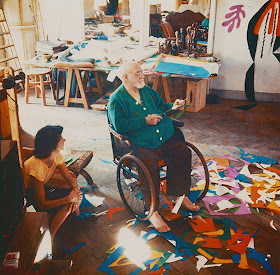January 27 was the 70th anniversary of the liberation of the death camp at Auschwitz. It also happened to be the day that I visited the Memorial to the Murdered Jews of Europe in the heart of Berlin. The memorial itself, with its hundred of grey stelae, stretching over a large space is certainly memorable (and has been controversial) but the exhibition itself in the information center underneath the memorial was a moving demonstration of the ways in which clarity and a conscious hand on what we present and how we present it can make an experience memorable. The exhibit has no objects--and it's not very big--just two of the what I'm sure were many constraints successfully addressed by the exhibit team.
You enter the space and begin by a hallway timeline, just images and text, about the Nazis efforts to exterminate the Jews and others. I didn't linger here, as it was crowded, but was interested in how many people were taking time to read the text. But you turn the corner and you see the image at the top of the post, large, at the end of a room. Just six people, representing the 6 million. You understand immediately that this is not a story just about numbers, but about people. And that focus on individual people is the thread that carries through.

Next, a space with large back-lit panels on the floor. Each one had a reproduction of a fragment of a letter written from a camp; along with English and German transcriptions. I was traveling with college students and one said afterward, "I felt obligated to read every single one." When I asked her to explain, she described it as more a responsibility--that she owed it to each of those people to read the text, honor and acknowledge them.

Those individual people all had families. The next space had six stories, of six families, from all across Europe and what happened to them, told just in photos and text. A different student said he connected more directly with this room; really understanding the idea that whole families, from all across Europe were lost forever. Again, the curatorial skill made concepts real and concrete.
As I entered the next gallery, I found darkness just a single name projected on all four walls, grey benches to sit on, and audio, first in German and then English. Again, it was about individuals. Each name was a person murdered by the Nazis and again made each person real, made you feel you were meeting a person.


A final room talked about the camps themselves. A map located them all over Europe and again, panels provided specific information. The panels created small booths, where individuals could sit down and listen to the voices of survivors about the camps. Throughout the exhibit there always felt a kind of intimacy, in a way an antidote to the bureacracy that carried out the murders.
I spend a great deal of time thinking about interactives or about how to create dialogue in museum settings, or how to make objects compelling. This museum, so clear in its focus and intent, reminded me that although we have an ever-greater number of tools in our interpretive toolboxes, the clear, thoughtful minds and eyes of exhibition developers and designers may be the most important.

As I came up out of the museum on this anniversary, I saw an older couple walk up to one of the stones and gently lay two bouquets of white flowers down and then spend time walking among the dark grey stones, under a dark grey sky and my eyes welled up. Remember.


.JPG)












